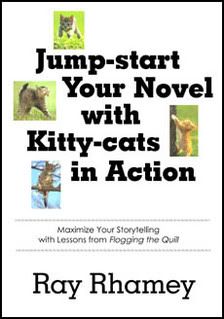Writing for Effect
By Ray Rhamey | March 20, 2008 |
 The following is adapted from the first chapter of the book I plan to publish based on my blog, Flogging the Quill. Jump-start Your Novel with Kitty-cats in Action will have new and expanded material that adds up to a bookful of coaching on the craft of creating compelling fiction.
The following is adapted from the first chapter of the book I plan to publish based on my blog, Flogging the Quill. Jump-start Your Novel with Kitty-cats in Action will have new and expanded material that adds up to a bookful of coaching on the craft of creating compelling fiction.
For what it’s worth…
Writing for effect is the core principle underlying my approach to creating irresistible fiction that immerses a reader into the experience of the story.
It’s the lens through which I critique narrative in an edit and work to view my own writing.
It’s the objective that informs the coaching on storytelling, dialogue, description, and technique in my book.
It’s knowing how to show and when to tell. It’s why most adverbs are weak writing.
It is the guiding light that can show you the way to a stronger story, and the searchlight that can illuminate shortcomings in your manuscript.
Failure to write for effect is why too many writers, especially beginning novelists, do little more than put information on the page, and the result is a report with a plot. Published authors frequently exhibit the same failing.
In storytelling, you’re not writing to inform the reader—you deliver information, of course, but that’s not the purpose—you’re writing to affect the reader. To craft narrative that creates an effect in the reader’s mind—the experience of the story.
Not a report telling what happens; the experience of the story.
Stimulus/response
Maybe it’s the psychology major in me, but I can’t help but think of the stimulus/response paradigm. You, the writer, produce a stimulus. The reader provides the response. The nature of your stimulus determines the reader’s response. What could be more simple? In practice, it isn’t simple, but it is the key to writing for effect, and that’s what opens the door to successful storytelling.
You begin a story with a single stimulus—a word. Here’s one now:
Vladimir’s
Most words can’t do much by themselves, so you string more words into a sentence that forms a different stimulus.
Vladimir’s blade sliced open the guard’s throat, and Vladimir smiled.
Change one word, and the effect is different. For example, consider the first verb, sliced. To my mind, it’s far more evocative than, for example, cut.
Another part of the effect here is to characterize Vladimir—for some reason, he enjoyed slicing open a man’s throat. And this sentence raises story questions: why did he slice the throat, and why did he smile? All that from just one sentence of ten words.
Although we’ve written for effect, and the accumulating stimuli produce a dramatic portrayal of what’s happening, it doesn’t yet reach the level of delivering the experience of the story.
Vladimir is the point-of-view character, but so far the narrative is objective, a camera’s view. Novels provide a unique way to create an experience—showing what’s happening in a character’s mind.
Vladimir’s blade sliced open the guard’s throat. The child-killer toppled, hands clutching his neck. Vladimir watched him writhe, and then become still. The bittersweet taste of vengeance filled Vladimir, and he smiled.
Your sentences accrue and, done well, congeal into a greater stimulus—the story. The final result, the effect on your reader, begins with the word choices you make and how you put them together.
 As for the rest…
As for the rest…
My book continues for 225 or so more pages, including a unique workbook style section where you join me in critiquing/editing samples from the “floggings” I do on the blog.
If you’d like to know when Jump-start Your Novel with Kitty-cats in Action is available, please e-mail me ray at editorrr dot com and I’ll send you a note.
Thanks for listening.
Photo and artwork credit: Ray Rhamey










wow, scary picture today!!! ray, i’ll take whatever help i can get. just don’t hurt me!!
These are good reminders, Ray. Sometimes I get so caught up in making sure the details fit, that I forget I need that emotional response to work…and too many details can undercut that.
KKIA–I hope you have a chapter on kung-fu kitties whomping on Vladimir. :-)
That IS a scary picture, but it drove home a great post, Ray, thanks. And best of luck with this project!
Ray,
Surely that’s not you in the picture, although I’ve felt like it after you shredded a couple of my submissions. Seriously, sounds like a great book.